Hibiscus has become popular worldwide for its big flowers and health benefits. Taking care of Hibiscus is not difficult if you get acquainted with its proper care requirements.
Hibiscus needs 6-8 hours of sunlight, regular watering and fertilizing, warm temperature, high humidity, and yearly repotting. Otherwise, it will face challenges like discolored, deformed, and wilted leaves. Provide the plant with its basic requirements and be prepared to fix any problem.
If you are a beginner at growing Hibiscus and seeking the basic needs and ways of dealing with problems, this guide will help you.
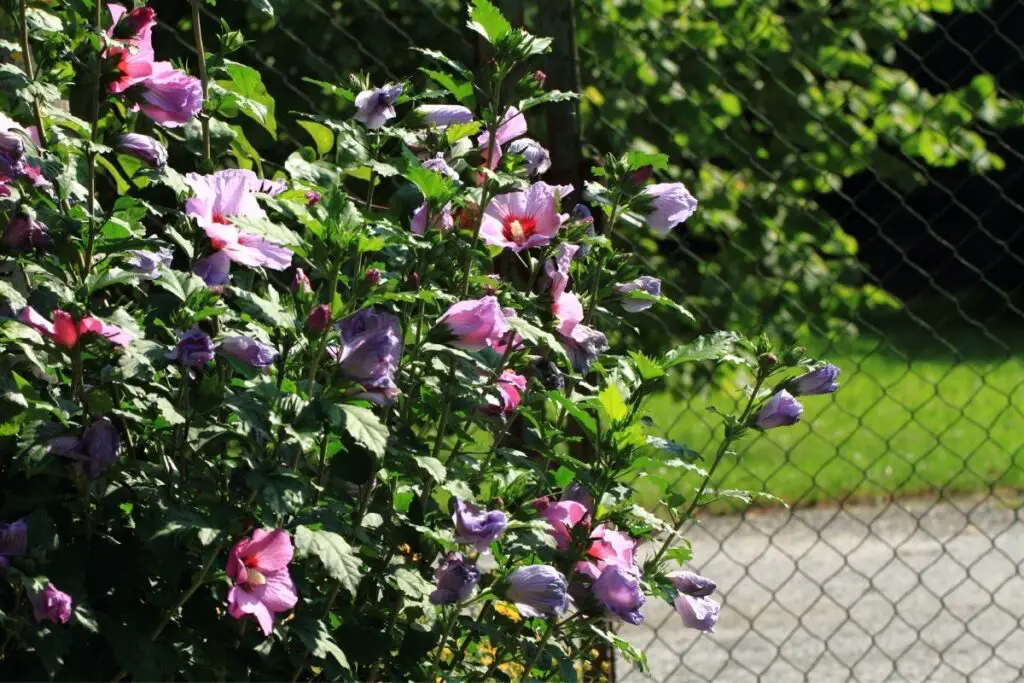
Hibiscus: An overview
Hibiscus plants are a genus of flowering plants, and they belong to the mallow family, Malvaceae.
Hibiscus has a wide range of varieties native to tropical and subtropical regions.
The common type of Hibiscus is Hibiscus Rosa-Sinensis.
Though it is called the Rose of China, it is believed to be an Indian plant, and Indians spread it in the south and Pacific Islands.
China is the place where Hibiscus cultivation began.
Europeans picked up this flower while exploring China many years ago.
It is said that the double red variety of Hibiscus was one of the earliest descriptions from Europe in 1678.
Description
Hibiscus leaf color varies depending on the variety.
They have a smooth structure covered with trichomes.
The flowers are big, bell-shaped, that grow singular or in clusters.
The stamens are united into a tubular structure. Hibiscus comes in red, pink, white, yellow, etc.
Hibiscus benefits
There are many benefits of Hibiscus. Hibiscus tea is a popular drink that benefits people in many ways.
The tea:
- Protects antioxidants
- Lowers blood pressure and cholesterol
- Promotes weight loss
- Fights inflammation and bacteria
- Maintains good liver health
- Relieves constipation
In Egypt, the flower is used to make a drink called Karkade. In Iran, people prepare “sour tea.”
In Africa, Latin America, and Caribbean Islands, a drink called Sorrel is made with it.
Are Hibiscus plants easy to grow?
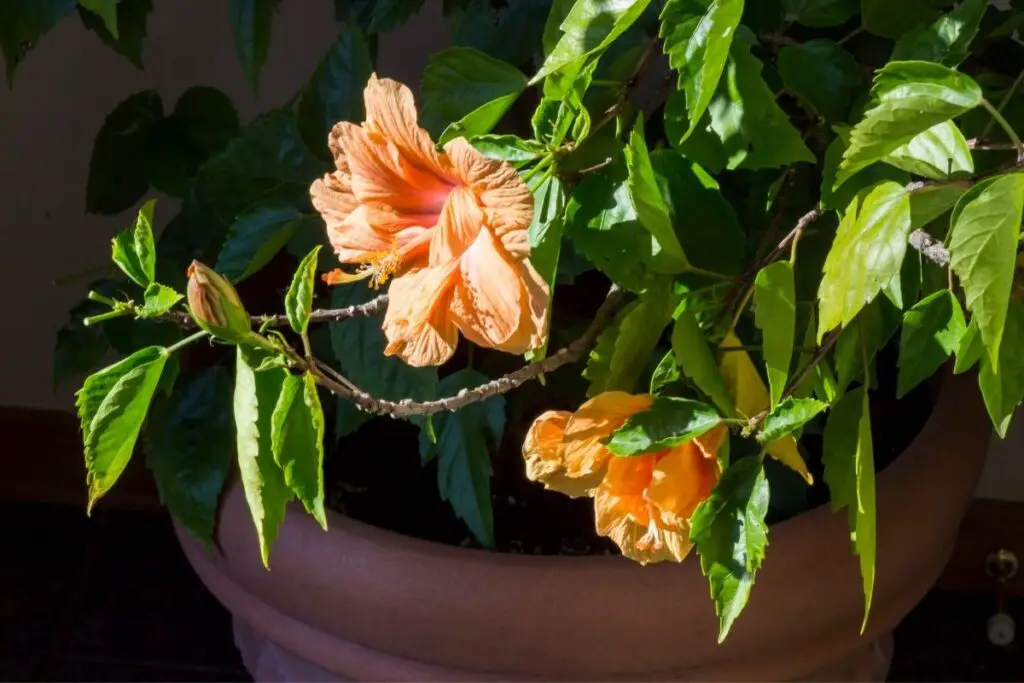
Hibiscus plants are easy to grow.
They don’t demand much and will be good for beginners.
You will find it effortless to grow once you know all their basic requirements.
No matter how easy Hibiscus is to grow, it would help if you learned about its key needs to keep the plant healthy in the long run.
Are Hibiscus indoor or outdoor plants?
Hibiscus plants can be grown both indoors and outdoors.
You need to know the right care tips and follow them in time.
There are two types of Hibiscus – Hardy, and Tropical.
Hardy varieties can be grown the whole year outdoors without any problem.
But, in some areas, Tropical varieties should be grown indoors, especially in winters.
Also read: Is Hibiscus An Indoor Or Outdoor Plant?
Hibiscus varieties
There are two types of varieties in general – Hardy and Tropical.
The Hardy Hibiscus plants are frost-tolerant and ideal for zones 4-10.
They are also called hybrid varieties.
They die in winter but come back in the next spring.
The flowers last for 2-3 days.
Hardy Hibiscus can be grown outdoors throughout the year.
They belong to the variety Hibiscus Moscheutos.
Some Hardy varieties are:
- Berry Awesome
- Blush
- Cranberry Crush
- Luna Red
- Mars Madness
Rose of Sharon is also a cold-tolerant plant, but it is not the Hardy variety because it is not a hybrid one.
Rose of Sharon belongs to the variety of Hibiscus Syriacus and zones 5-8.
The Hibiscus plants that belong to Rose of Sharon are:
- Aphrodite
- Lavender Chiffon
- Lucy
- Minerva
- Sugar Tip
Tropical Hibiscus plants are tender, low-growing shrubs plants.
They are native to zones 9-11 and cannot tolerate cold weather.
So, they are treated as annuals.
Their flower lasts for only a day.
They belong to Hibiscus Rosa-Sinensis.
Tropical Hibiscus plants have the following species:
- Black Dragon
- Eye of Kali
- Nairobi
- Fiesta
- Hawaiian Sunset
All about planting Hibiscus plants
Let’s understand the when, where, and how of planting Hibiscus plants.
When to plant Hibiscus?
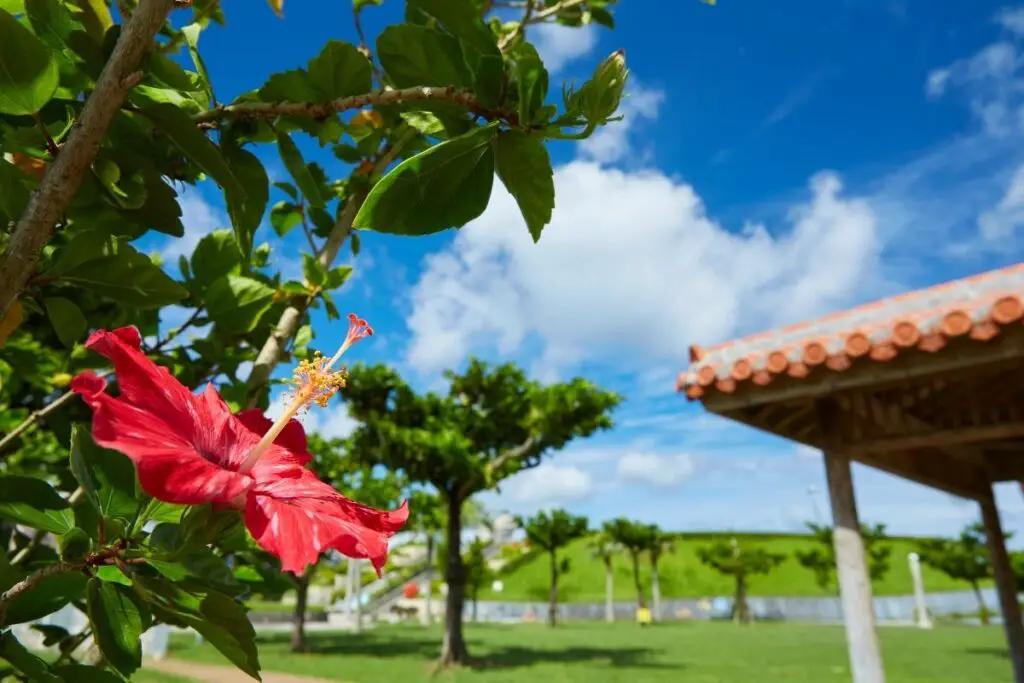
Hibiscus plants are best grown in warm weather, i.e., spring.
Since it is their growing season, they will develop well after plantation.
Even if they face any injuries, the growing season and proper care will help them recover faster.
The best time for growing Tropical Hibiscus is spring and early summer.
For Hardy Hibiscus, the best time is spring and fall, when there is no risk of frost.
Also read: When Do Hibiscus Bloom? (+How Long Does A Hibiscus Bloom Last)
Looking for gardening supplies? We have tested 100's of products before recommending them to you guys. Check out our best pick below:
| Image | Gardening Supplies | Best Price? |
|---|---|---|
 Top
Top Top
Top | Raised Garden Bed Kit | Check On Amazon |
 | XLUX Soil Moisture Meter, Plant Water Monitor, Soil Hygrometer Sensor for Gardening, Farming, Indoor and Outdoor Plants, No Batteries Required | No Results |
 Top
Top Top
Top | 82 Pcs Garden Tools Set and Extra Succulent Tools Set | Check On Amazon |
 | Joeys Garden Expandable Garden Hose with 8 Function Hose Nozzle, Lightweight Anti-Kink Flexible Garden Hoses, Extra Strength Fabric with Double Latex Core, (50 FT, Black) | No Results |
 Top
Top Top
Top | Dual Chamber Compost Tumbler | Check On Amazon |
 Top
Top Top
Top | Sunnyglade Plant Stakes | Check On Amazon |
 Top
Top Top
Top | Organic Cold Pressed Neem Seed Oil | Check On Amazon |
 Top
Top Top
Top | Mighty Mint Gallon :-Insect and Pest Control Peppermint Oil | Check On Amazon |
 Top
Top Top
Top | Scotts DiseaseEx Lawn Fungicide | Check On Amazon |
 Top
Top Top
Top | Jacks Classic 20-20-20 All Purpose Fertilizer | Check On Amazon |
 Top
Top Top
Top | 30,000 Seeds Pollinator Attracting Wildflower Mixture | Check On Amazon |
 Top
Top Top
Top | Survival Vegetable Seeds Garden Kit-Over 16,000 Seeds | Check On Amazon |
Where to plant Hibiscus?
If you grow Hibiscus in your garden, find the sunniest spot in your garden.
For that, you need to understand the direction of sunlight in your area.
The best location is a place that receives 6 to 8 hours of bright sunlight and some shade in the afternoon.
In most cases, the sunniest spot is southern or western direction.
Some tall trees around the location would be better as they will protect from the afternoon sun, especially in summers.
Ensure the soil quality too before planting (we will share later).
Plant Hibiscus in your garden’s northern or eastern side if you are from warmer zones.
The sunlight will be at its peak in the southern or western direction and burn your plant.
Planting Hibiscus in these two directions will also bring your family luck and spread positivity.
If you belong to colder zones, choose the southern or western direction.
Also read: Where To Keep Hibiscus Plants? (Ideal Spot+Tips)
How to plant Hibiscus?
If you grow Hibiscus on the grounds:
- Find an ideal spot and dig a hole at a depth of the roots.
- Place your plant in it and cover the roots and plant base surroundings with the soil.
- Tap the sides to settle down the soil.
- Water a little to moisten the soil.
- Ensure the plant receives some partial shade as it is still not ready to handle direct sunlight. Expose it to direct sunlight after it settles down.
- After some months, fertilize the plant as required to boost the growth.
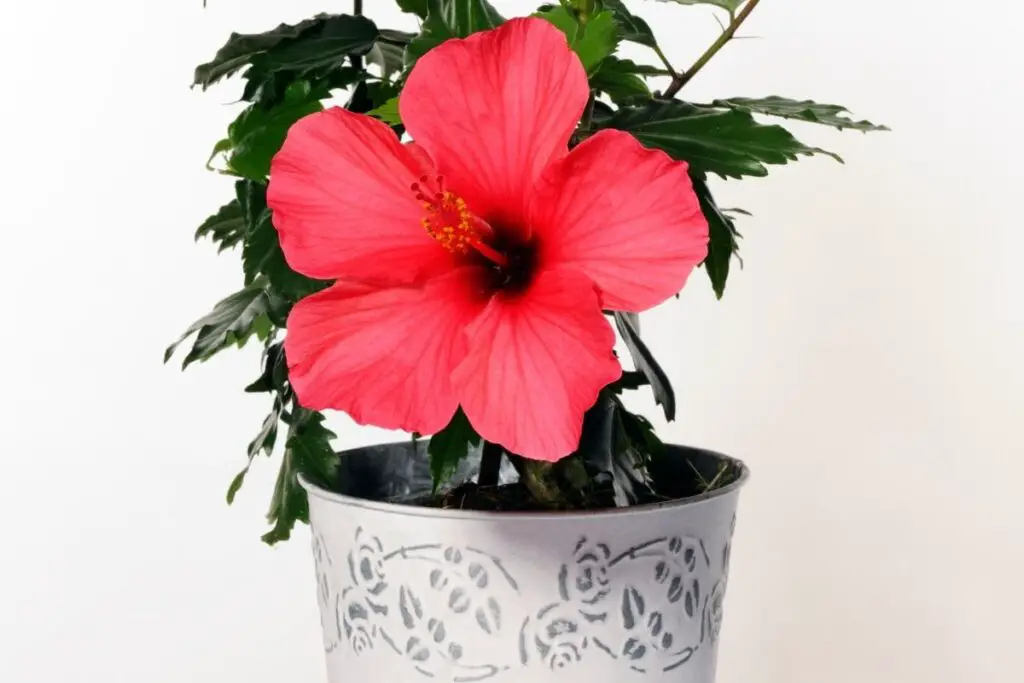
For potting:
- Get an ideal type and size of the pot.
- Fill it in half with a suitable potting mix.
- Make a hole and place the plant in it.
- Cover the roots with the remaining soil mix.
- Water the plant to moisten the soil.
- Place it under indirect sunlight for some days. Once established, be gradual and transfer it to the direct sunlight.
Also read: Can I Keep My Hibiscus Plant In A Pot? (Potted Hibiscus Care)
Hibiscus care guide
Once you are done planting, it is time to care for them.
So, let’s begin with the basic care tips.
Light requirements
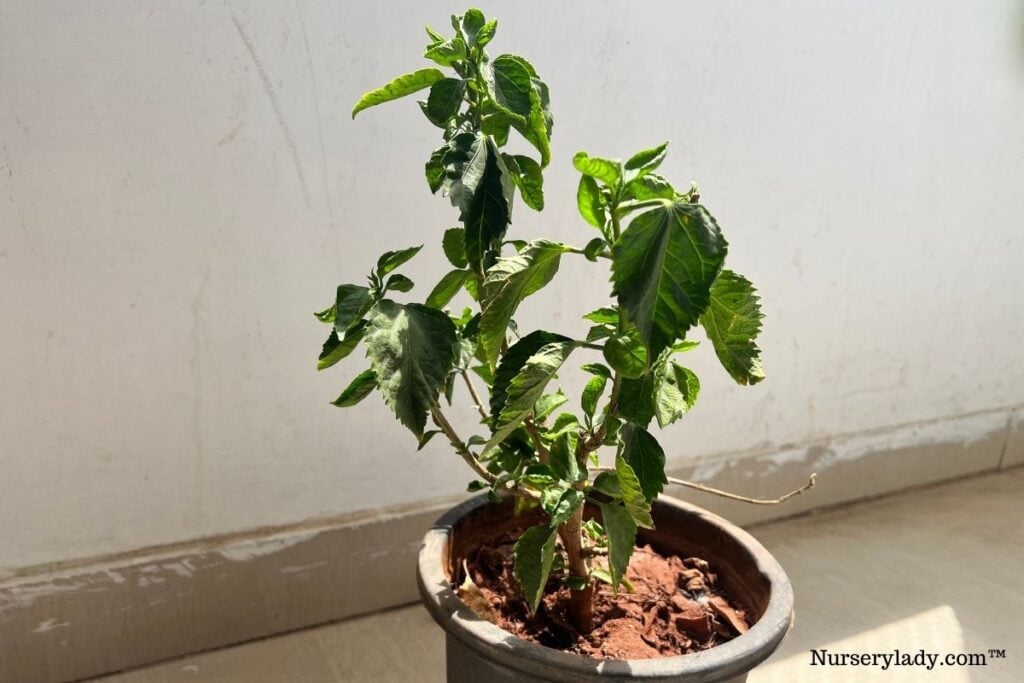
Hibiscus plants should receive daily 6 to 8 hours of sunlight.
For planting it in the ground, find the right location in your garden.
Find a place that gets sunlight throughout the day for 6-8 hours and some dappled shade in the afternoon.
If the plant receives shade, find its cause and take action to give the plant enough light, like shifting the plant or cutting branches of tall trees blocking the sun.
If the sun is harsh, fix shading nets.
But make sure that the plant receives partial sun because PAR light is important for them, and it is possible only if the plant gets some direct sun.
Also read: How Much Light Does A Hibiscus Plant Need? (What Kind, How Much & More)
Water requirements
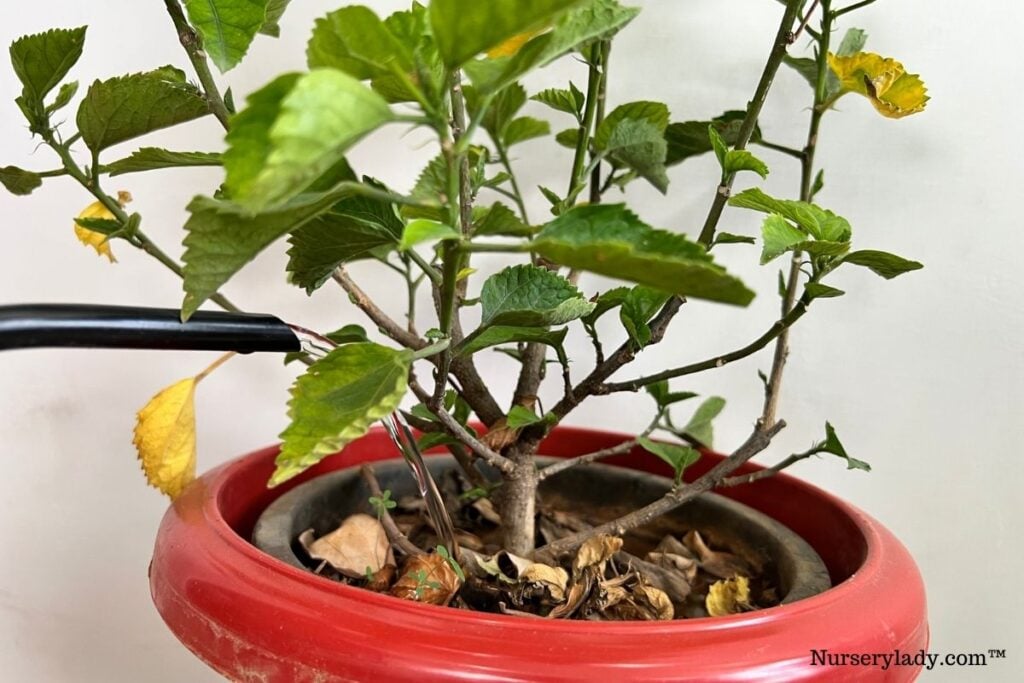
Water the Hibiscus plants well to maintain moist soil.
Remember that the soil should be moist and not soggy.
That would cause overwatering and root rot.
Let the soil dry before you water it next.
Don’t let the whole soil dry out before the next watering.
Always water the plant when the top 1-2 inches of the soil is dry.
In the summers, water Hibiscus daily.
Sometimes, they will need water 2-3 times per day.
In winter, reduce the frequency.
Since the plant growth will be slow, it will absorb water in small amounts, and the soil will take time to dry out.
Also read:
Soil requirements

Hibiscus needs well-drained loamy soil.
The soil should have a balance between retention and drainage.
Hibiscus does enjoy moist soil, but it also doesn’t like to stand over a pool of water.
Before planting Hibiscus on the ground, dig the top few inches of the soil, and add compost, coco coir, perlite, vermiculite, and sand.
Compost and coco coir improves retention, and the rest improves drainage.
For potted plants, consider the following soil mixes:
- 2 parts potting soil, 2 parts peat moss, and 1 part vermiculite or perlite
- Composted bark, composted manure, coarse peat, and little vermiculite
- 50% peat, 45% composted bark, and 5% perlite
- 2 parts garden soil, 1 part compost, and 1 part sand
Before planting Hibiscus, check the soil’s pH level (both potting mix and ground soil).
The pH level should be within 6.5 and 6.8.
During ground planting, check the permeability because water needs to reach the 6-inch root of the plant.
Also read: What Kind Of Soil Does A Hibiscus Plant Like? (+Best Soil Mix)
Fertilizer requirements
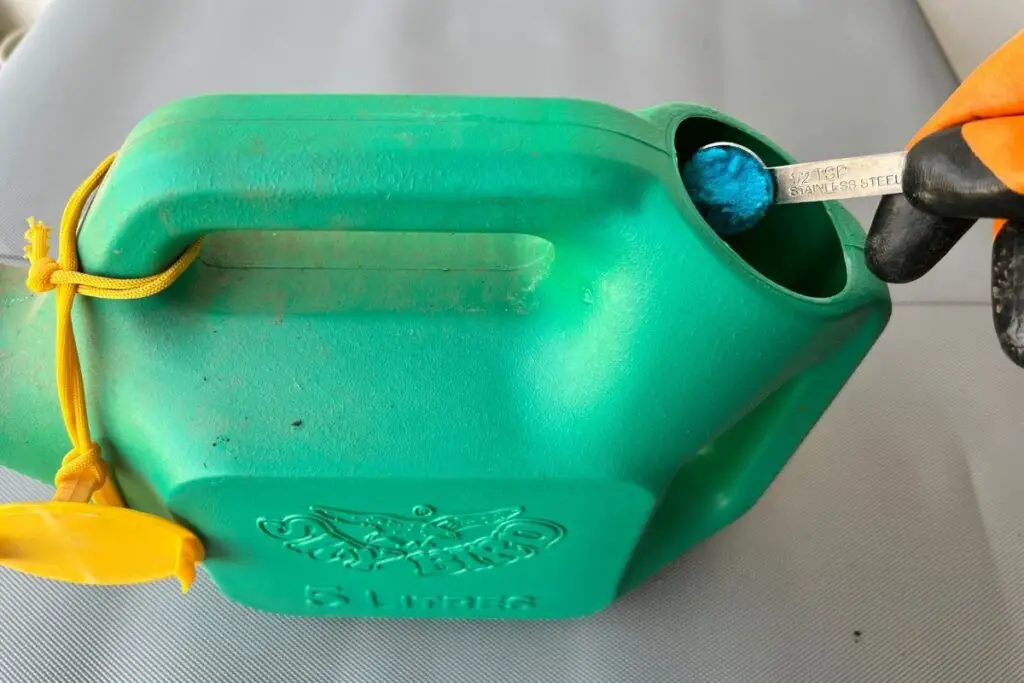
Hibiscus plants are heavy feeders.
They require a fertilizer having an NPK value of 17-5-24, 9-3-13, or 10-4-12.
The fertilizer should contain average nitrogen, low phosphorus, and high potassium.
Using the right formulation is essential.
Otherwise, fertilization would be pointless.
If you are using a liquid fertilizer, apply it every 2 weeks during the growing months and every 4 weeks in the winters.
It works instantly and provides the essential nutrients faster during flowering.
If you use time-release, apply it every 3-6 months and avoid it during winters.
Though you don’t have to reapply it too often, it doesn’t give the plant instant nutrients during flowering.
Some homemade fertilizers are Epsom salt, coffee grounds, vinegar, eggshells, banana peels, etc.
Also read:
- What Is A Good Fertilizer For Hibiscus Plants? (Ideal Ratio+Best Pick)
- Does Hibiscus Plants Like Coffee Grounds? (Pros & Cons)
Temperature requirements
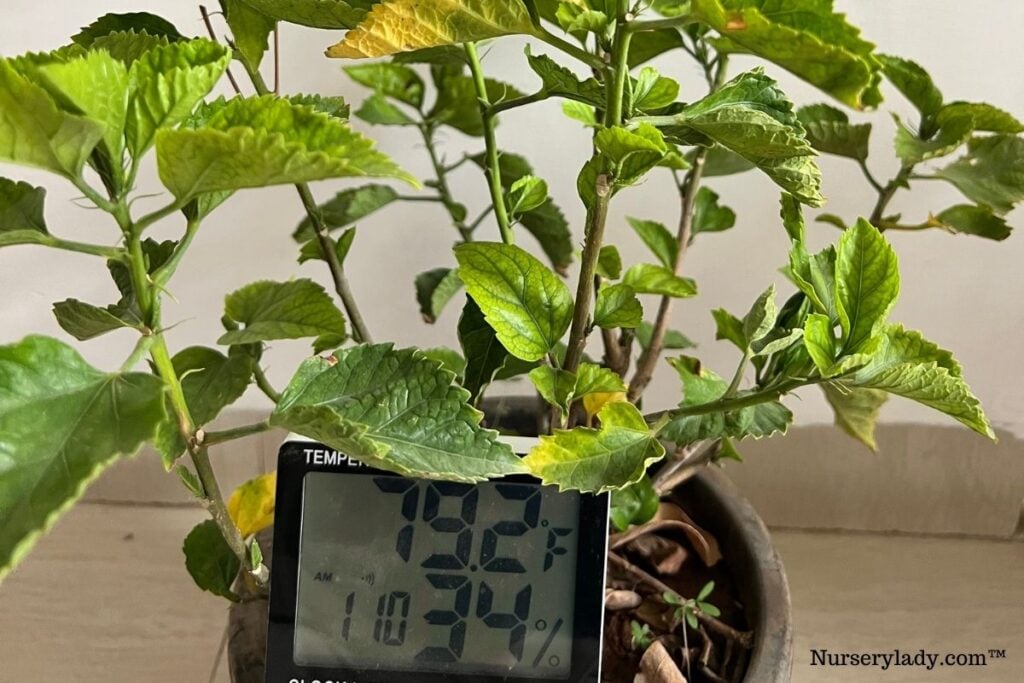
Hibiscus plants need a warm temperature ranging between 65°F and 75°F.
Their minimum temperature tolerance range is 50-55°F, and the maximum is 80-90°F.
Tropical Hibiscus plants are tender and, thus, are grown as annuals in colder regions.
Some Tropical varieties will tolerate a cold of 32°F.
To treat them as perennials, grow them indoors or shift them indoors in winter.
Hardy Hibiscus varieties are frost-tolerant and endure cold temperatures around -20 to -30°F.
So, you can keep them outdoors all the time.
They will die in winter and again come back in spring.
Hibiscus won’t tolerate temperatures above 95-100°F.
Above this range, the plant will get overheated and cause bud drops.
Also read:
- Hibiscus Temperature Tolerance: Ideal Range+USDA Zones
- Can Hibiscus Tolerate Cold Weather? (+Winter Care)
- What To Do With Frozen Hibiscus Plant? (Hibiscus Cold Damage)
Humidity requirements
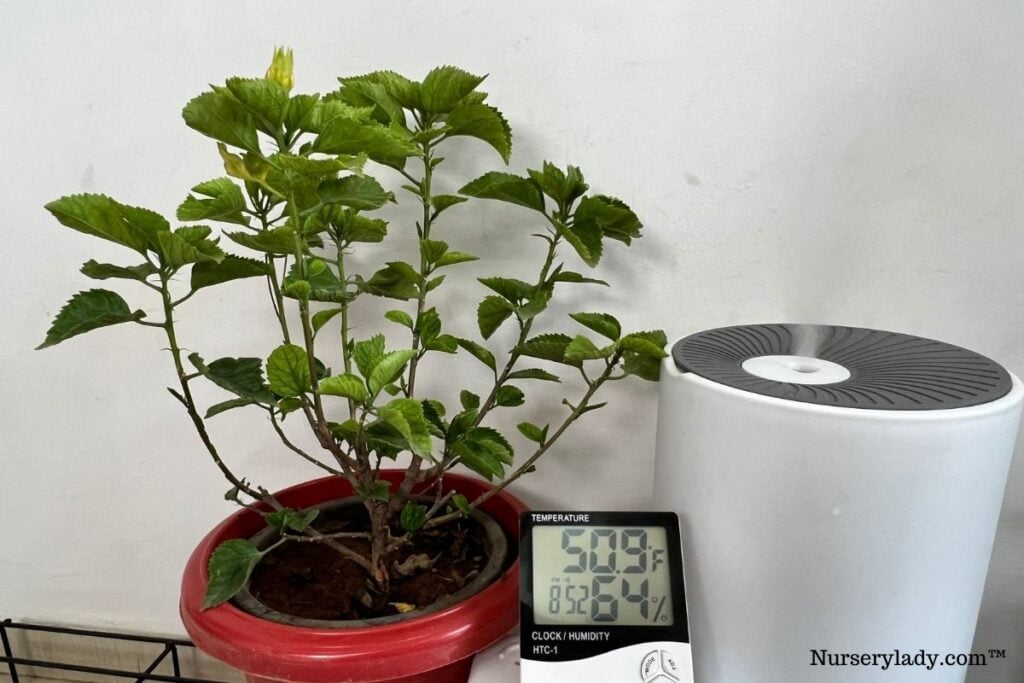
Since Hibiscus plants are from tropical regions, they need high humidity levels to survive.
Their average humidity levels are around 60-70%.
Hibiscus plants are provided with 90% humidity in some greenhouses, but they stay under special care.
In your home, maintain within 60-70%.
The levels shouldn’t drop below 50%; otherwise, the plant will suffer from dryness.
To increase humidity levels:
- Mist your plant or install a misting system for an outdoor setting.
- Keep pebble trays under the potted plants.
- Keep some water trays around the plant. As water evaporates, it adds moisture to the air.
- Group tropical plants so that every plant can create enough humidity for each other.
- Create levels with your plant so that the other plants’ dewdrops can fall over your Hibiscus. It works as misting and increases the plant’s humidity levels.
- Add compost to the base of your outdoor plant.
Also read: Do Hibiscus Like To Be Misted? (+Humidity Requirements)
Pot requirements
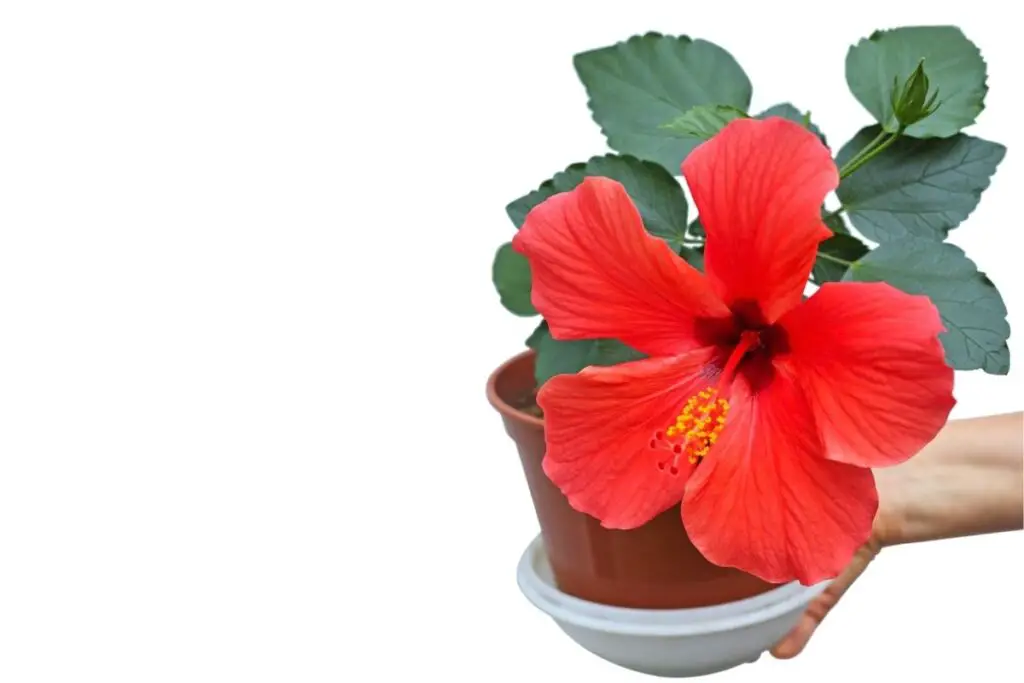
Hibiscus needs a pot proportionate to the plant’s size.
In general, a 10″ pot is ideal for a standard Hibiscus.
You can use it the whole if you don’t want their plants to grow bigger.
If you want the same, prune the roots 2″ at the root ball and keep it in the same pot.
If you want the plant to increase, take a 1-2-inch bigger pot than the old one during repotting.
Terracottas are the best because they are porous, aid in drainage, and are heavy to hold the plant.
It will also release the hot air from the roots and plant.
Plastics are also good because it holds moisture for a little longer.
It is good for Hibiscus because it enjoys moist soil.
Don’t use a black pot as black absorbs excessive heat.
But, plastic pots are lightweight and become brittle under the sun.
Ceramic pots are also good.
It gives your plant a simple yet sophisticated look and can hold your plant.
Ensure drainage holes before buying the pots.
Also read: What Kind Of Pot Is Best For Hibiscus? (Size, Material & More)
Repotting and rejuvenation
Repot your Hibiscus plant every year to save it from root-bound and give the plant fresh soil.
Fresh soil filled with fresh nutrients will boost the plant.
While repotting, use a pot 1-2 inches bigger than the old one.
If you want your plant to stay small, use the same old container but replace the soil.
If your plant is on the ground, dig the top few inches and add fresh ingredients like perlite, pumice, or compost to improve the soil quality and structure.
Do this every 1-2 years.
Also read: Should Hibiscus Be Root Bound? (+When To Repot)
Pruning
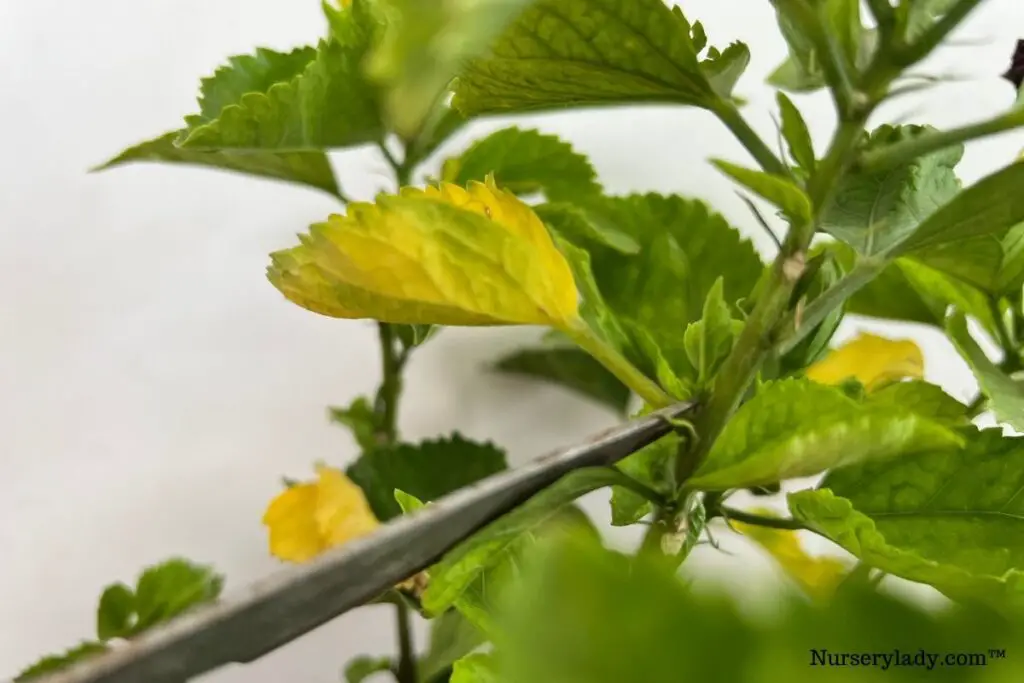
Pruning Hibiscus encourages new stem growth and flowering.
There are 5 types of pruning – selective, corrective, pinching, full and hard.
Full pruning and hard pruning are the main types of pruning.
Selective pruning is done with the branches that are not pointed in the right direction.
Cut them at the node from where you think the branch will grow straight.
The distorted and damaged branches are cut to correct the plant’s appearance in Corrective pruning.
Pinching means removing the tips of stems to encourage flower growth.
In the case of Full pruning, leave 2-3 nodes above the stem and cut the stem 1/4th above the fourth node.
In Hard pruning, leave behind 2-3 nodes in each branch and remove the rest at the above.
Hard pruning is done only with mature plants that don’t bloom well.
Prune Tropical Hibiscus in the early spring. Hardy Hibiscus is pruned during the early spring and late winter.
Also read: How To Prune Hibiscus? (A Step-By-Step Guide)
Propagation
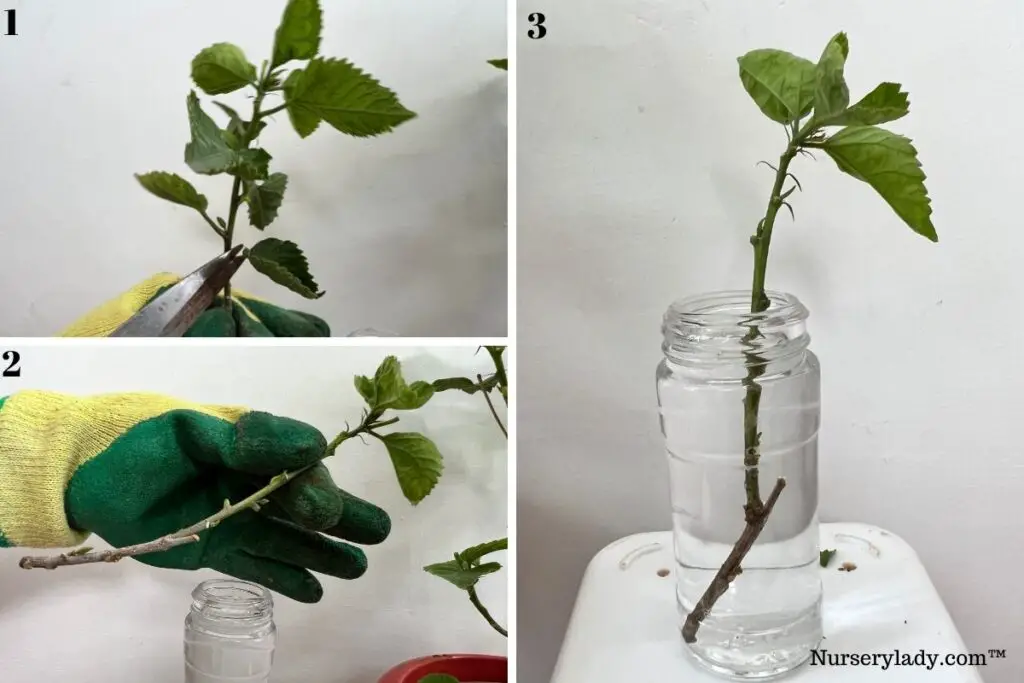
Propagate Hibiscus to get more Hibiscus plants.
Stem cuttings are the easiest method of propagation.
- Find a healthy stem and cut it around 6-8 inches 1/4th inch above the node.
- Cut the end at a 45° angle and scratch the ends to expose the cambium layer around 1-2 inches at 1-2 sides.
- Dip the end into the rooting hormone and plant it in the ideal soil mix.
- You can also dip it into the water. Transplant it into the soil once the plant develops roots and turns light tan color.
The next method is from seed.
- Collect the seeds, rough them in sandpaper, and soak them overnight.
- Next day, take a pot, fill it up with ideal soil mix and plant the seeds at ¼th inch deep.
- Moisten the soil. The seeds will take 2-4 weeks to sprout.
- Harden them and then expose them to the bright sunlight.
These two are the common ones.
There are two more methods, but they are not much popular –air layering and root cutting.
If you want to perform them for experience, check the propagation article.
Also read:
- How To Propagate Hibiscus? (4 Methods+Step-By-Step Guide)
- Can You Grow Hibiscus Cuttings In Water? (+How To)
Toxicity
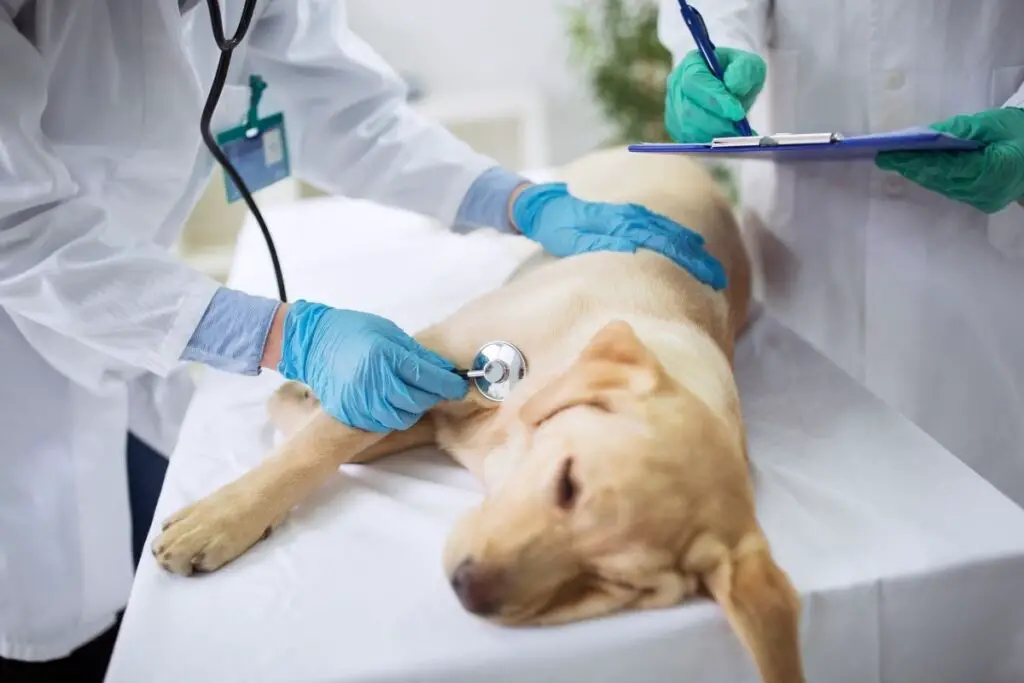
Hibiscus is considered non-toxic except for Rose of Sharon.
It contains an amino acid called Asparagine.
If ingested, the pets will have vomiting, diarrhea, loss of appetite, internal blisters, corneal damage, etc.
Even if the other varieties are non-toxic, keeping the pets away from Hibiscus plants is better.
The roots are more poisonous.
Consumption will lead to vomiting, mouth infection, and diarrhea.
Since Hibiscus is high in fiber, some animals are allergic to fiber.
However, you can sometimes feed your pets with dried Hibiscus flowers.
They are good in antioxidants and vitamin C and improve digestion and energy level.
Also read: Are Hibiscus Poisonous To Pets? (Cats, Dogs & Other Animals)
Hibiscus problems
If taken proper care of, Hibiscus will thrive well and bloom profusely.
But, the plant will still face some problems due to some unfavorable conditions.
Sometimes, gardeners make become careless and unaware or are beginners.
Here, we will share the problems and the ways to deal with them.
Yellow or brown leaves

Yellow or brown leaves could be due to overwatering, underwatering, poor soil quality, improper pH level, improper fertilization, sunburn, low light, fertilizer burns, temperature variations, pest infestations, and dormancy.
- Always water the plant when the top 1-2 inches are dry. If you have overwatered, check the soil and stop watering for some days. If underwatered, consider thorough watering. Within a few weeks, your plant will come back normal.
- Sometimes, fast-draining soil or slow-draining soil also causes dehydration and overwatering. So, use the right soil mix.
- High phosphorus content or improper pH levels block the plant from absorbing nutrients, causing nutrient deficiency and yellow or brown leaves.
- Check the fertilizer you use. If it has high phosphorus, stop using it and send your soil for testing. Don’t fertilize for some days until recovery. If the problem is with pH levels, use wood ash or lime to fix the pH. Always fertilize your plant in the spring and summer. Please don’t skip it.
- Lowlight causes yellow leaves, and sunburns cause yellow leaves with white dots. If you ever see these signs, take steps to solve the problem. If the low level is low, shift your plant to a sunny place. If branches of other tall trees are blocking the light, cut some of them. If the light is harsh, fix shading nets. Find a place that receives some shade in the afternoon.
- If the temperature is too high (above 95-100°F), shower your plant every week and protect it from the sun. Remove the discolored leaves to make the plant focus on new growth.
- Excessive fertilization accumulates salt, which further absorbs all the moisture, thus making it dehydrated. Direct fertilizer application over dry soil or wet leaves burns the roots and leaves respectively, thus causing browning. Flush the soil 2-3 times and stop fertilizing for 2-3 weeks. Clean the leaves if you have applied direct fertilizer by mistake. Always moisten the soil and then fertilize.
- The plant lacks nutrition and moisture because the sap-sucking bugs have sucked it all, making the leaves yellow or brown. Use Imidacloprid, neem oil, insecticidal soaps, and rubbing alcohol to remove them from the plant.
- Dormancy is natural. At the end of the fall, the leaves turn yellow and fall off the plant. The plant will grow new leaves and flowers when the temperature warms up in spring.
Also read:
- Why Are My Hibiscus Leaves Turning Yellow? (Causes+Fix)
- Why Are My Hibiscus Leaves Turning Brown? (Causes+Fix)
White leaves
White leaves are the result of powdery mildew.
It is a fungal disease that happens during humid and moist conditions.
It seems as if someone spread talcum powder on the leaves.
Remove the affected leaves but don’t prune if most of the leaves got affected.
Apply Neem oil to the infected leaves.
It works as an amazing antifungal agent.
Another reason behind white leaves is mealybugs and whiteflies.
When they stay in your plant leaves in communities, the leaves look white.
To deter them, spray Neem oil and insecticidal soaps.
Since both are sap-suckers, consider systemic treatment with Imidacloprid.
In sunburns, the leaves look yellow and white dots all over the surface.
To fix it, shift your plant to a shady place or fix shading nets on your planting site.
Also read: Why Are Hibiscus Leaves Turning White? (Causes+Fix)
Curly leaves
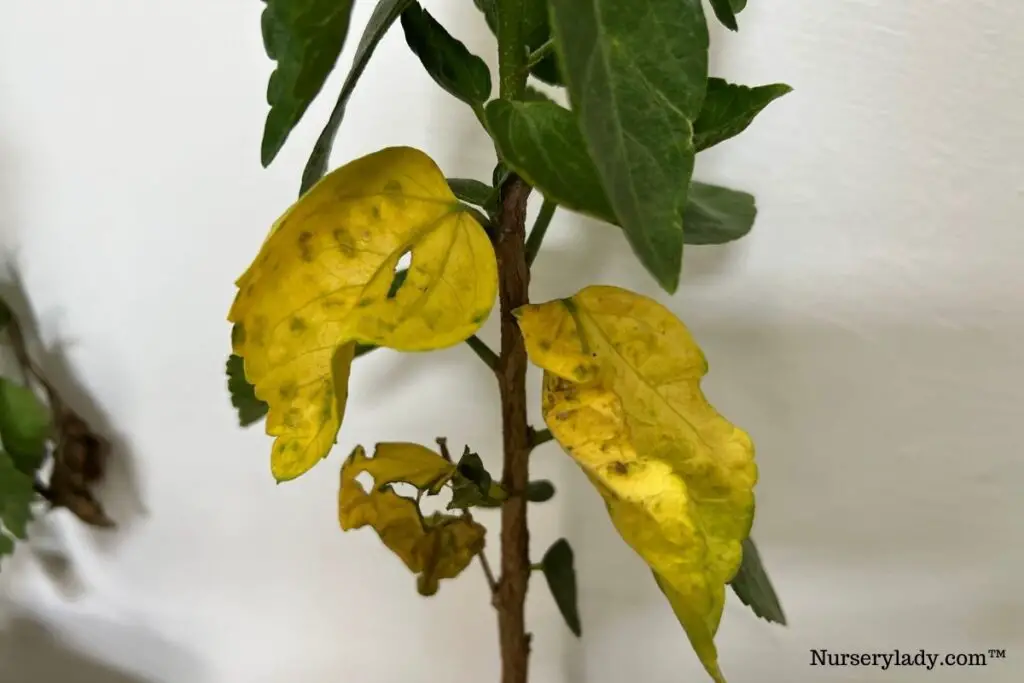
Common reasons are dehydration, temperature variations, sunlight, pests, and diseases.
If it is dehydration, check the soil condition and water the plant well to moisten the soil well.
Your plant will perk up within a few days.
The leaves curl inward to save themselves from the direct sun and high temperatures (above 95°F).
To fix it, give your plant some shade, shower it every week and increase watering to cool it down.
When attacked by bugs, the bugs suck the plant sap and make the leaves curl and wither.
Please treat them with Neem oil, soapy water, and pesticides.
Diseases like leaf spot and root rot will cause curly leaves.
You need to remove the affected parts, maintain hygiene, and spray fungicides to control the disease.
Also read: Why Are My Hibiscus Leaves Curling? (Causes+Fix)
Droopy leaves
Poor watering habits, low sunlight or extreme heat, transplant shock, pests, and diseases are the reasons for droopy leaves.
Improve your watering habits by checking the soil – water when the top few inches are dry.
Hibiscus plants are sun-lovers.
So, never deprive them of light.
But you shouldn’t also let them have the harsh sunlight.
Some dappled shade is fine.
Transplant shock sometimes causes droopy or yellow leaves.
The plant faces a change in its growing condition and thus reacts to the change.
It is natural.
Your plant will be fine once it gets adjusted to the new environment.
Fix pest problems with Neem oil, insecticidal soaps, and rubbing alcohol.
Use pesticides only as a last resort.
For fixing diseases, use a fungicide.
Also read: Why Is My Hibiscus Plant Leaves Drooping? (Causes+How To Fix)
No budding or bud drop
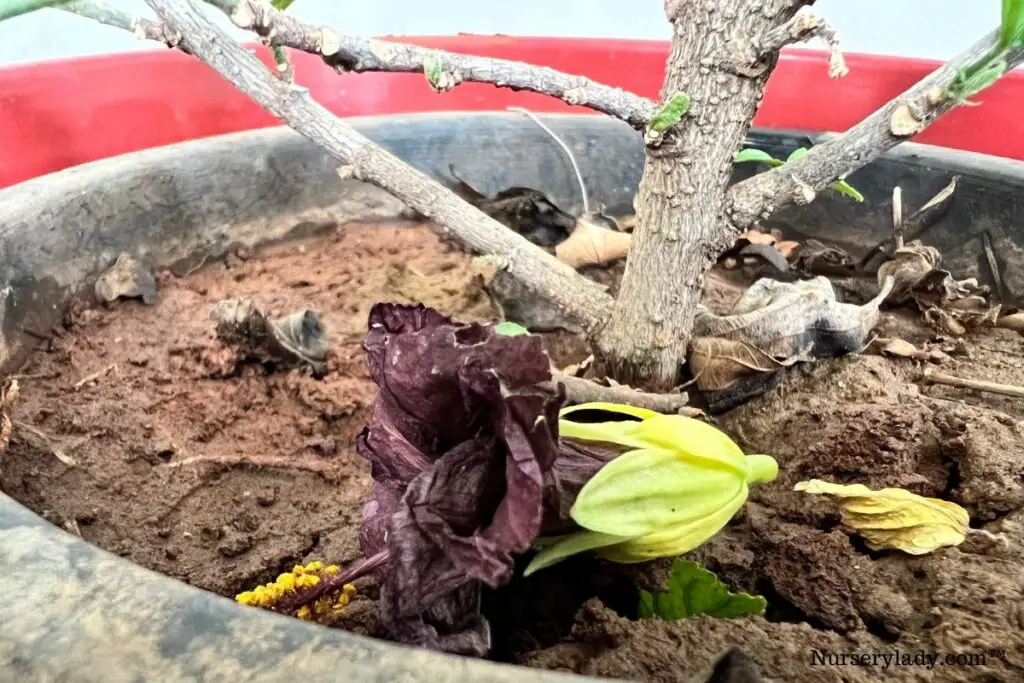
The major reasons for no buds are high phosphorus, improper pH levels, high nitrogen, and low light.
High phosphorus and improper pH levels block the plant from absorbing the nutrients present in the soil.
Without proper nutrition, the plant cannot use its energy to produce buds, thus causing no budding.
High nitrogen levels make the plant concentrate more on leaves and plant growth than flower buds.
That is why the plant doesn’t grow any flower buds.
Low humidity and extreme heat are responsible for bud dropping.
Hibiscus needs 50-70% of humidity.
Low humidity makes the plant lose moisture.
Due to this, the buds will dry out, dehydrate, and fall off.
Humidity shouldn’t drop below 50%.
Excessive heatwaves overheat the roots, causing premature bud drops.
Provide the plant with some shade, shower it every week and increase watering.
If your plant is in a pot, put it in another big pot to stop the heatwaves from reaching the roots.
Thrips also cause bud drops because they stay inside the buds, scratch them inside and even lay eggs.
It makes the buds weak and falls off.
Use insecticidal soaps to the buds like Malathion or Acephate to fix it.
Also read:
- Why Is My Hibiscus Not Budding? (Causes+How To Fix)
- Why Won’t My Hibiscus Bloom? (+How To Make Hibiscus Bloom)
Defoliation
Too much or too little water, over-fertilization, environmental changes, dormancy, and infestations are some common reasons.
Improve your watering habits.
Fertilize at half the strength at the right time, and reduce application in winter.
Defoliation during sudden changes like re-locating and repotting are natural reasons.
Once the plant adjusts to the new surroundings, it will stop losing leaves.
Acclimatization is essential if you wish to shift your plant from inside to outside.
A sudden change results in sunburns and leaf loss.
Infestations will also make the plant lose leaves because it weakens the plant to a great extent.
The plant fails to hold the leaves, causing defoliation.
Pests
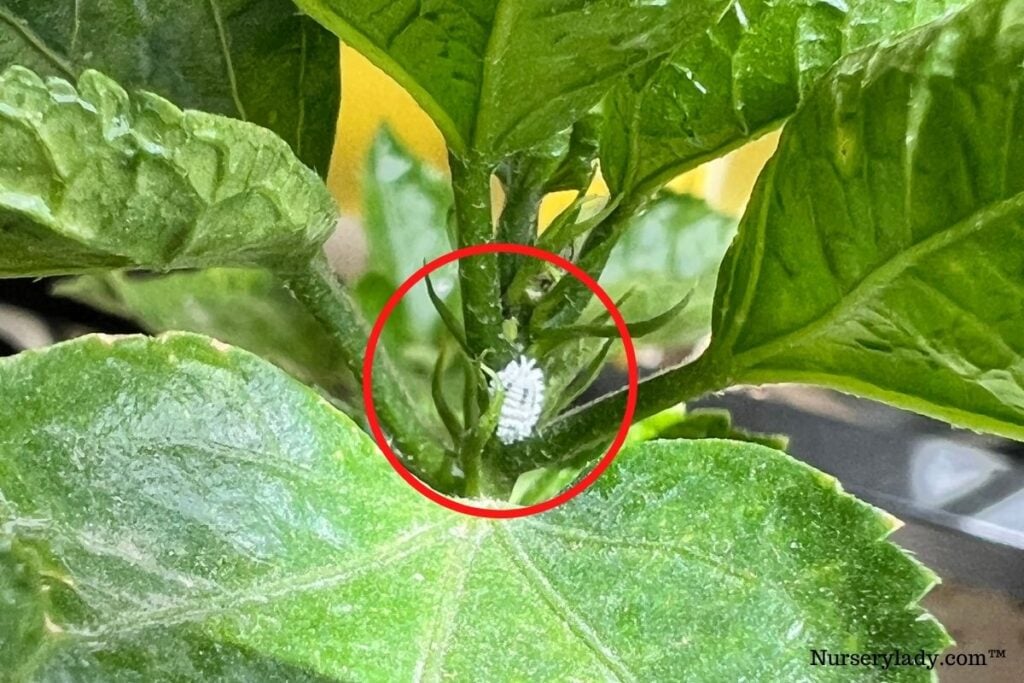
Pests like aphids, mealybugs, spider mites, scales, thrips, caterpillars, beetles, etc., are common Hibiscus bugs.
You can use Neem oil to deter them.
Coat the bugs with insecticidal soaps.
It will cut their oxygen and kill them.
For sap-suckers, try the systemic method with Imidacloprid.
For hard-shelled bugs like hard scales and mealybugs, use rubbing alcohol to weaken their shields.
Release natural predators like lacewings and ladybugs.
But you can’t use general pesticides while performing this treatment because the chemical can deter these predators.
Use products like Malathion or Acephate on the flower buds to treat thrips.
Thrips stay in the buds, scratches inside, lay eggs, and drop them.
Caterpillars and beetles skeletonize the leaves.
Shake your plant to dislocate them.
Use repellents like catnips, chives, or garlic.
Also read: How Do I Get Rid Of Bugs On My Hibiscus? (Common Bugs+Fix)
Diseases
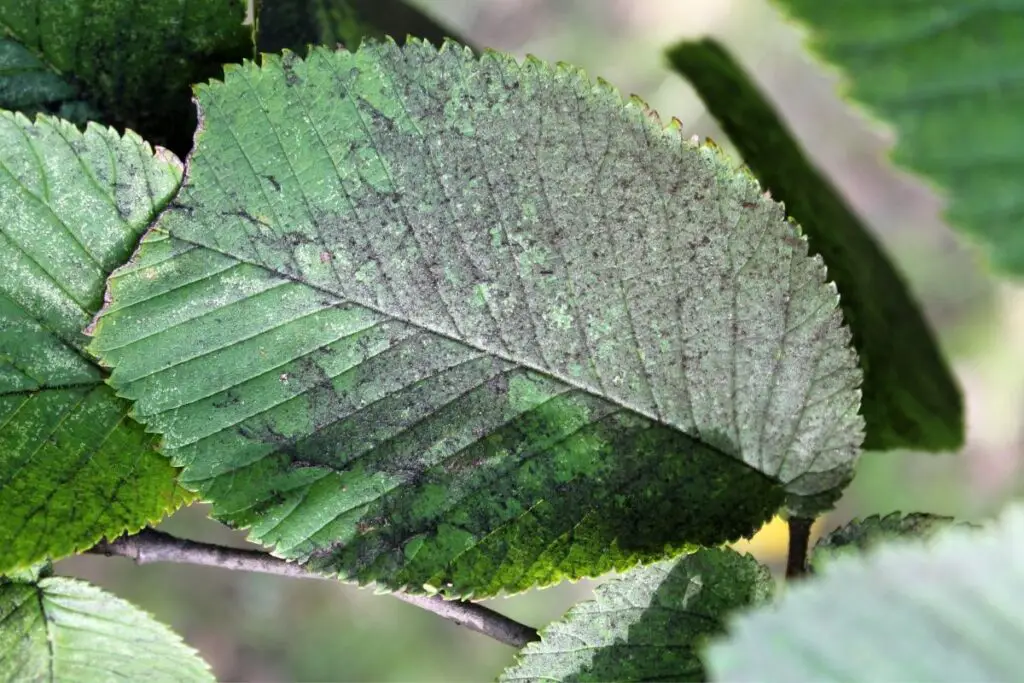
Common diseases are leaf spots, powdery mildew, root rot, sooty mold, gray mold, and roridum.
Leaf spot causes black spots on the leaf surface.
It weakens the plant, reduces photosynthesis, and makes it vulnerable to other diseases.
To control it, avoid overcrowding and extreme moist conditions, and keep the surroundings clean.
Here, you don’t need to apply fungicides.
The spots will diminish once the plant recovers.
Use baking soda and milk powder for powdery mildew besides Neem oil.
Mix 1 teaspoon of soda, ¼ of water, and some vegetable oil together.
Mix them and apply them to the infected leaves.
Take 1 part milk powder and 3 parts water. Mix well and apply to the infected leaves.
Sap-sucking bugs leave behind honeydew and invite black sooty mold.
The black color is a coat over the leaf surface.
To clean this, use soapy water.
Let it stay for 15 minutes, and then wash off with clean water.
To prevent sooty mold, control pest infestation first.
Root rot causes due to prolonged overwatering.
Roots begin rotting after staying wet for a long time.
To fix it, take the plant out, remove the damaged roots, spray some fungicide and repot it in a new pot with new soil.
Gray mold causes black spots on the leaves and flowers.
High moisture levels during warm temperatures are the common reason.
To prevent the disease:
- Increase air circulation.
- Spray the plant fungicide containing chlorothalonil.
- Avoid overhead watering and wet mulches.
Myrothecium roridum is a soil-borne disease that causes crown or stem rot.
It kills new growth, stops new leaf growth, and provokes necrotic tissue.
- Avoid unnecessary injuries, over-fertilization, and overhead watering. Spray fungicide to help the plant fight the disease.
- Improve airflow and keep the plant healthy by feeding them well and maintaining hygiene.
Also read:
- Why Are My Hibiscus Leaves Turning Black? (Possible Causes+Fix)
- Why Are Hibiscus Leaves Sticky? (Causes+How To Fix)
- How To Save A Dying Hibiscus Plant? (8 Causes+Fix)
Final thoughts
Here are the points that I have discussed in the guide:
- Let Hibiscus have 6-8 hours of sunlight all day and some shade in the afternoon.
- Water when the top 1-2 inches are dry. Neither let the whole soil dry nor let the plant stand over a pool of water.
- Use well-drained loamy soil that drains and retains well. Use the recommended mixes for better results.
- Fertilize your plant from time to time in the growing season. Reduce frequency in winters.
- Maintain a temperature of 65-75°F and 50-70% humidity levels.
- Repot and replace the soil every year for healthy plants and fresh nutrients.
- Prune the plant in time to encourage new stem and profuse flowering.
- Though Hibiscus is non-toxic, keep it away from pets.
- Check your plant daily. Take immediate action if you ever spot pest and fungal infestations.
- Spray your plant once every 15-30 days to prevent infestations.
Also read: 11 Care Tips For Hibiscus Plant
Reference: Wikipedia, ASPCA, Louisiana State University Agricultural Center, American Society for Horticultural Science, Tropical Hibiscus by Texas A&M University, Sciencedirect.
